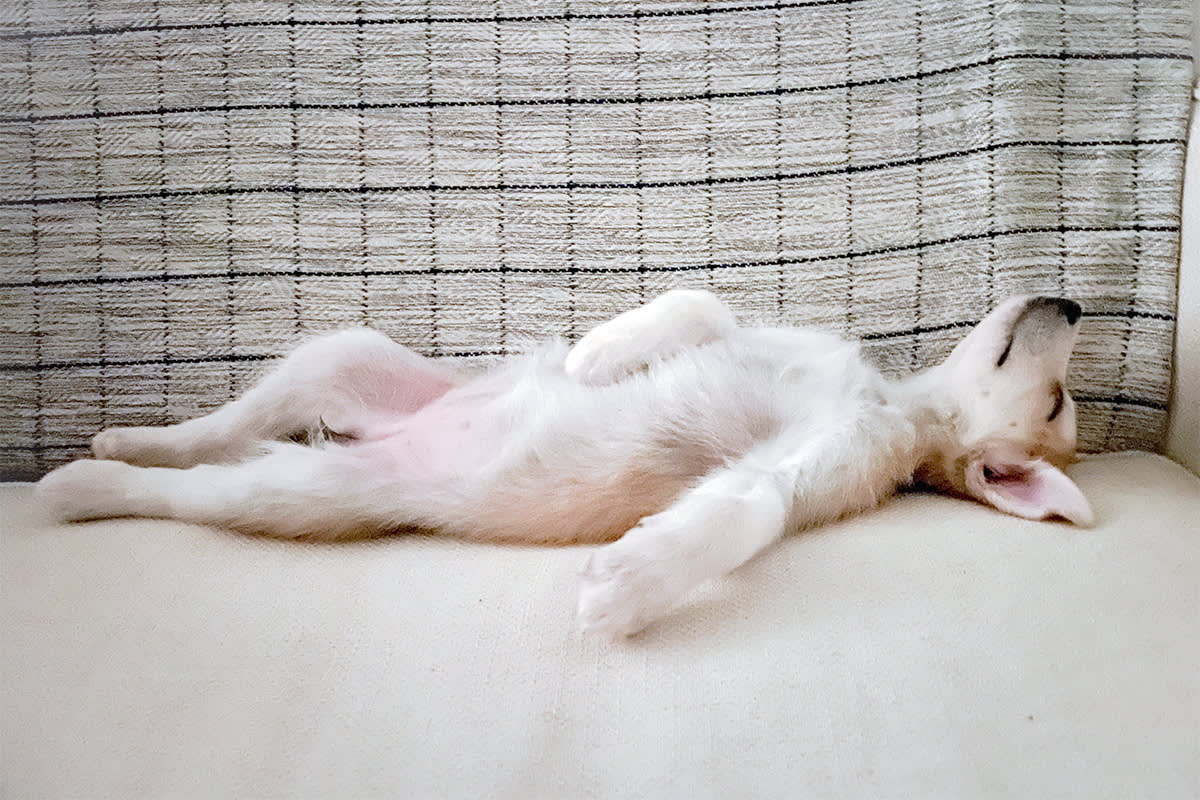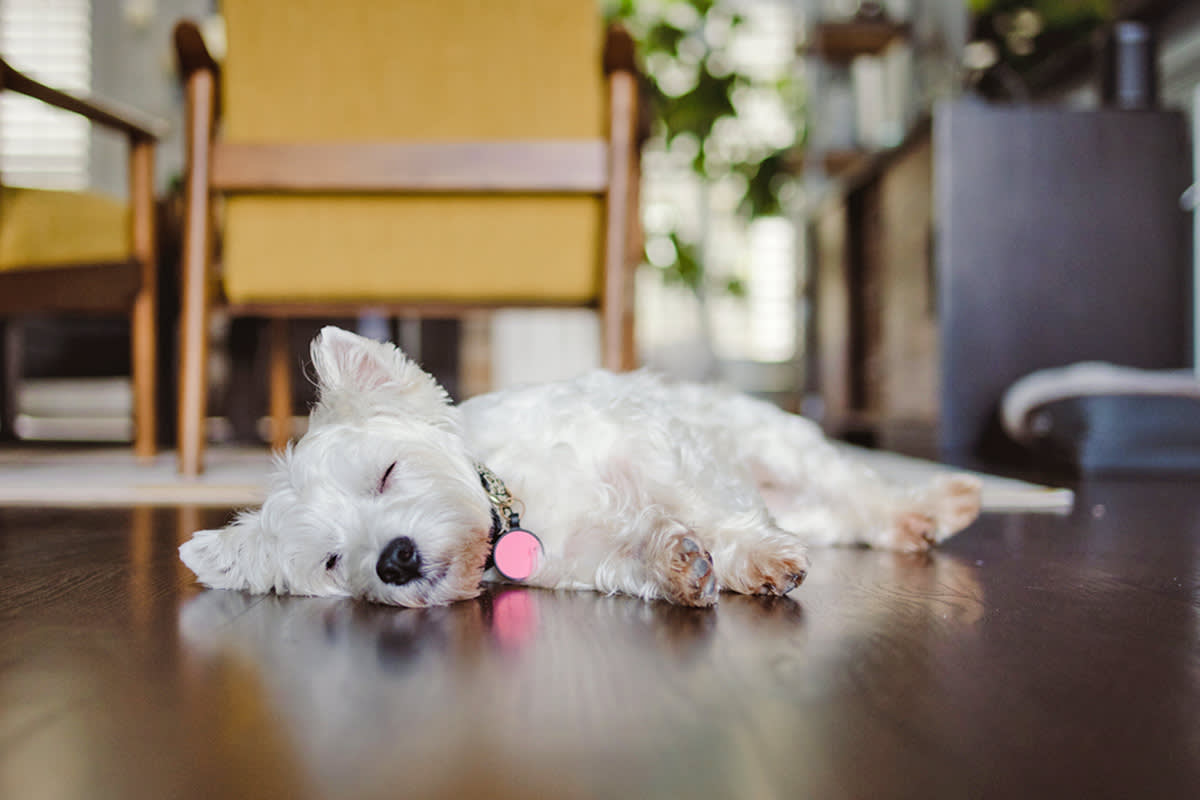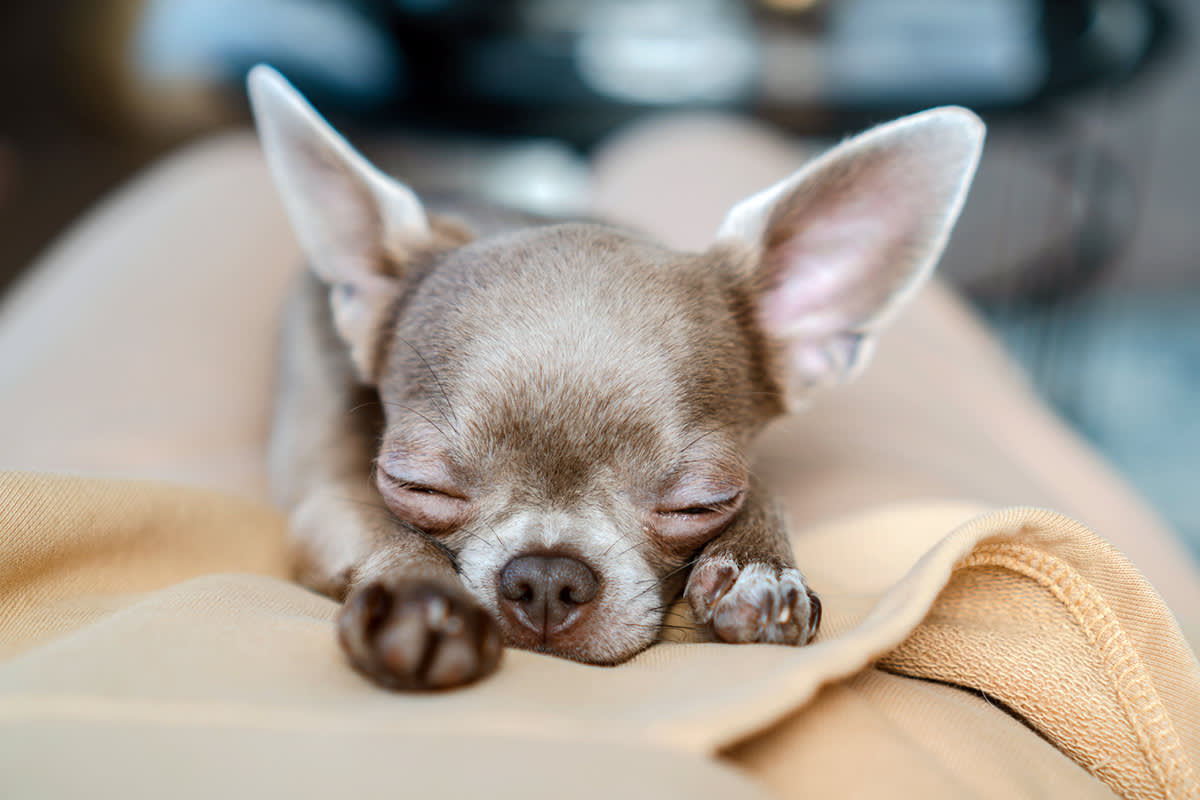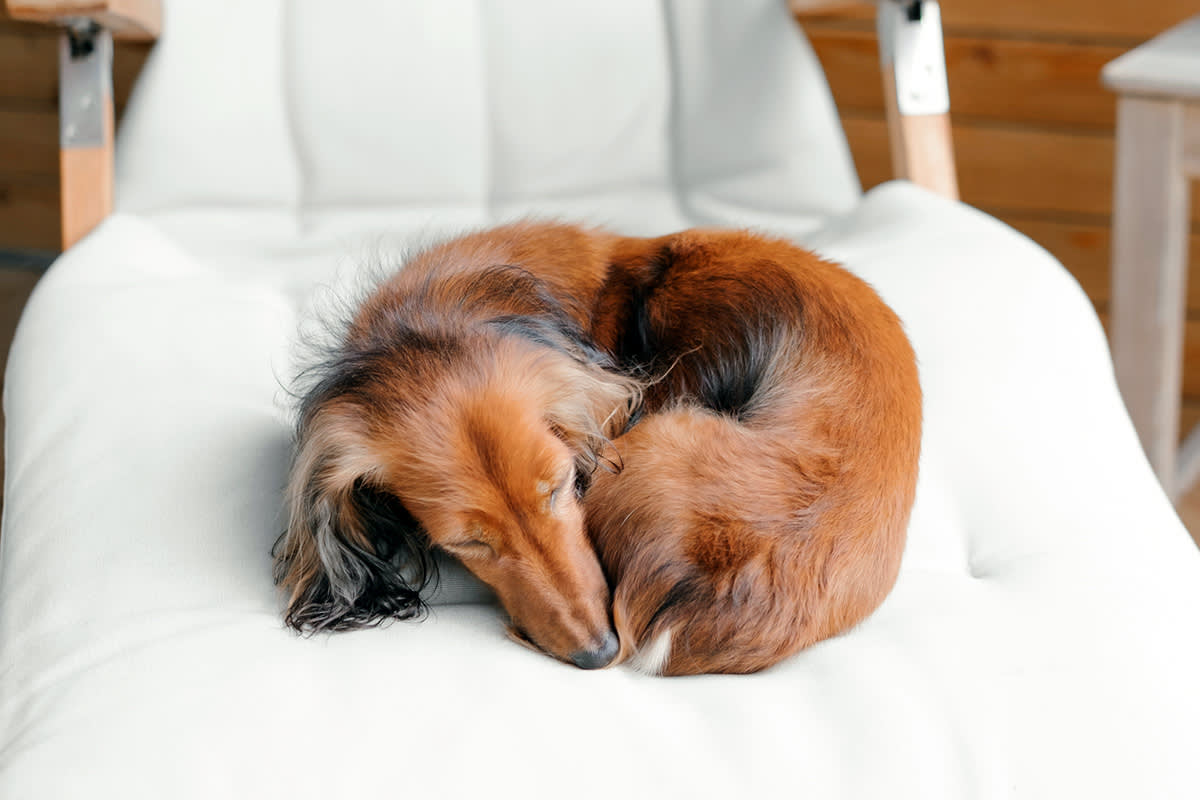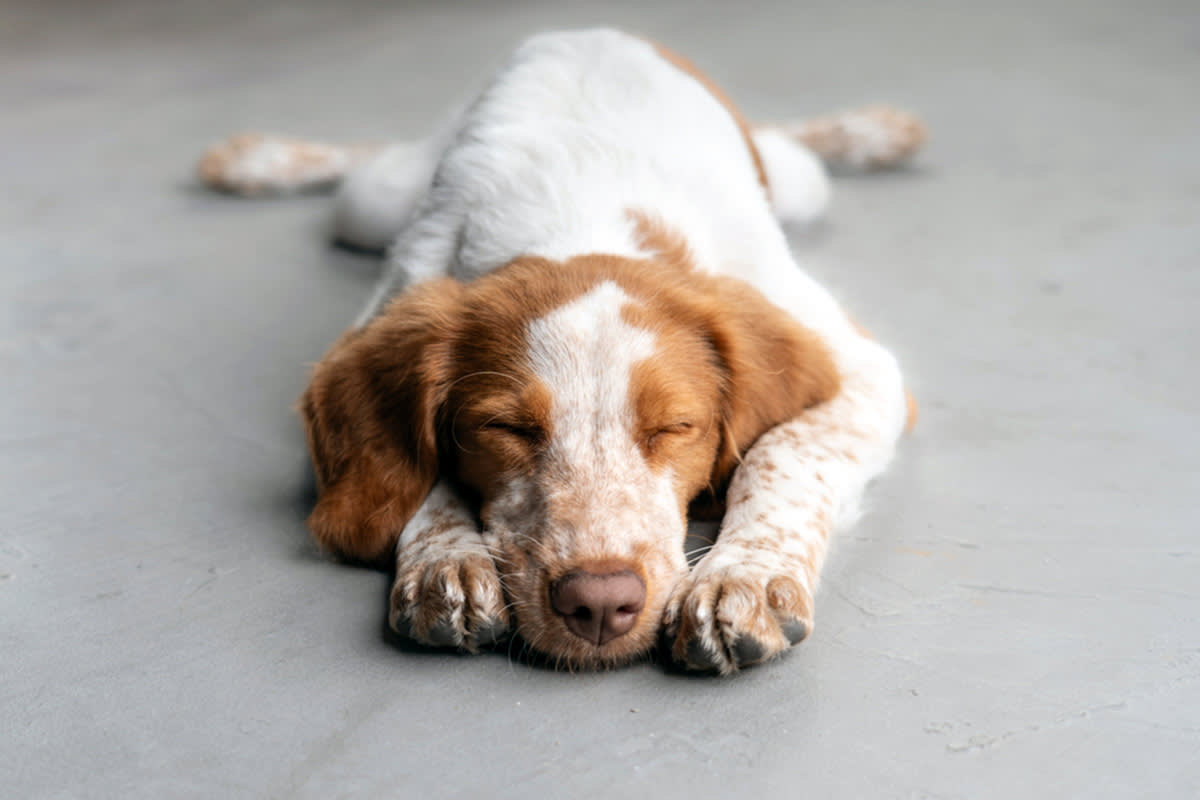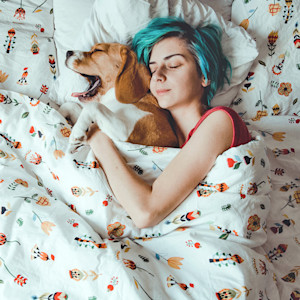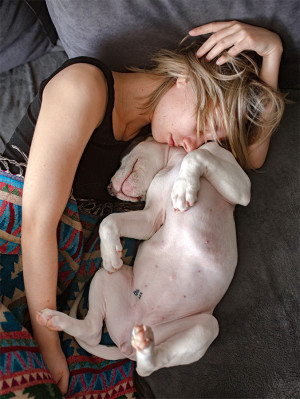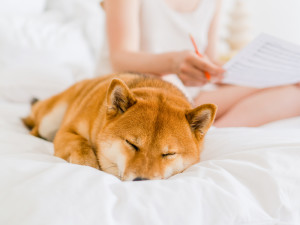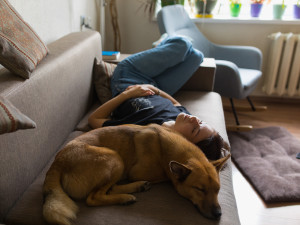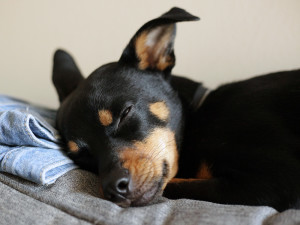What Does Your Dog’s Sleeping Position Say About Them?
Is your pup a splooter or a donut? It turns out, you can learn a lot from how your dog snoozes.

Share Article
We’ve all been there: You walk into a room and find your dog looking adorable, peacefully napping under a sunbeam, and let out a sigh. How are we lucky enough to exist in the same universe? you might wonder. And then, you take a closure look and notice the bizarre position your dog is in — on his back, perhaps, with a paw stuck in the air — and you wonder, How the hell is that comfortable?
Dogs sleep in all kinds of positions, some more logical than others. But what do any of them mean? It turns out, you can learn a lot from how your dog sleeps. Mike Armstrong CPDT-KA, owner and the lead trainer for Woof Works Trainingopens in new tab, gave us a few tips to better understand our dogs’ favorite naptime formations.
What does dog's sleeping position tell us?
Usually, your dog’s favorite snoozing stance can speak to one of three things: their physical comfort, their emotional comfort, or their temperature. You might need context clues to decide which one it is.

Back sleepers
If your dog likes to rest flopped out on his back, tummy in the air, Armstrong offers two possible scenarios. “My two big interpretations of that are, they’re completely trusting of their surroundings — they are totally fine with everything — [or] … they could be hot and they're trying to cool themselves off,” he says.
Dogs that expose their bellies while at rest are showing vulnerability by leaving their vital organs unprotected. More cautious dogs will shield their abdomens from harm. Then again, if your home is getting a little stuffy in the summertime, you might also find your dog splayed out to cool off.
Younger dogs, in particular, can be more prone to sleeping on their backs. As they get older, they might switch to a different position that’s easier on their backs and hips.
Side sleepers
This one’s another classic for dogs who feel at home. If your dog often sleeps on their side, legs outstretched or folded up like little chicken wings, “It generally means they feel pretty relaxed and trusting, comfortable in their surroundings, not threatened, all of that,” Armstrong says.
Sphinx sleepers
No, your dog is not sleeping on his stomach with his front legs outstretched because he’s developed a newfound interest in Ancient Egypt (although, if you happen to leave the Discovery Channel on a lot, I suppose we’ll never know for sure). Instead, Armstrong says, “That usually means that they feel more alert.”
The “Sphinx” pose, also known as the “Lion” pose, could mean that your dog wants to be able to stand up at a moment’s notice. At the same time, Armstrong cautions against reading too much into the position as a surefire sign that your dog feels on edge. “It could certainly mean that,” he says. “But again, some dogs will lay in those positions because it's the most comfortable at that moment.”
Donut sleepers
If you ask me (and sadly, no one has), this one’s actually the cutest pose in the book. Really, how could anything be more adorable than a dog curled up into the tiniest, tightest little ball, tail tucked beneath their chinny-chin-chin?
Depending on context, Armstrong says, donut-prone doggies could be experiencing a couple different things: They’re either feeling a little self-protective (again, hiding those precious internal organs), or they’re feeling a little chilly. Understandably, this position is particularly popular among newly adopted dogs who are still adjusting to their new home.
“We see that a lot with, especially, dogs who come to do board-and-trains if we haven't done a lot of work with them prior,” Armstrong says. “Our kennel room is different from our training room, and so if they haven't spent a lot of time in there, for example, you'll see them, especially the first few days, in that position.”
All dogs are different, so don’t freak out if your dog occasionally likes to transform into a coil. They could be cold or simply comfortable in that position. That said, Armstrong notes, “If your dog is persistently in the donut, I would keep an eye on that.”
If you’ve recently adopted a dog who still only sleeps in the “donut” position after a few weeks, it could be a sign that they’re not quite settled in. “If that persisted, then there could be an issue and how they perceive you,” Armstrong says. “They may not feel safe around you because you may not be a calming influence on them.”
But this doesn’t mean your relationship has to stay that way. Work on your bond through play, positive reinforcement training (treats always help!), and reading their body language. If you understand their boundaries —like when they may not want hugs, snuggles, etc. — they will learn to relax with with you. As cute as the donut may be, if you do these things, and you may just see them uncoil.
Splooty sleepers
Yes, we could also call this the “Superman Pose,” but honestly, where’s the fun in that? For the uninitiated, splootingopens in new tab is when a dog (or other animal — I’ve seen squirrels do it) splays itself on the ground stomach-down with legs extended.
This position is popular among younger and older dogs. Puppies sometimes fall asleep in this position, and seniors might favor it because it’s easy on their hips. If it’s hot outside, your dog might also be using the cool floor to cool off his tummy.
Generally, Armstrong says, he’d infer that dogs in this position are feeling relaxed. Puppies might also try to use this position to initiate play while awake.
Why do some dogs burrow under blankets?
If it’s cold outside, there’s always a possibility that your dog just wants to be warm. They could also simply want the comfort and security that comes from sleeping under a big, cozy blanket. As Armstrong puts it, “Some dogs do not want to be under anything, and some will insist on it, even when it’s hot.”
As with many other sleep preferences, Armstrong says most pet parents shouldn’t read too much into burrowing behavior. But if your dog refuses to come out or ducks under the covers in response to certain noises, then you might want to explore the behavior further. If it’s fear-based, some gentle training can help your dog overcome it.
When to see a vet
For the most part, sleeping positions and behaviors are benign. As strangely as dogs might seem to behave when they’re dreaming, all that twitching and light barking is normal and healthy. Armstrong notes that some clients have asked about dogs that like to sleep with their heads propped up on a pillow or surface. This is usually not a cause for alarm, but if you notice labored breathing, it might be worth running by your vet. That way, you and your pet can both rest easy.

Laura Bradley
Laura is a New York-based experienced writer and mom of two rescue pups. Her work has appeared in Slate, Vanity Fair, Daily Beast, The Washington Post, The Atlantic, Yahoo! News, Vulture, Grazia Magazine, and more. When she is not writing or walking the pooches, you will probably find her in the community garden.
Related articles
![Woman sleeping in bed with her beagle dog.]()
Does Your Dog Get a Bad Night’s Sleep When They Share a Bed With You?
You might be stealing all the covers.
Why Does My Dog Twitch In Their Sleep?
Dogs twitch in their sleep for many reasons.
Why Does My Puppy Breathe Fast While Sleeping?
And is it normal?
![Shiba inu dog sleeping in bed]()
My Dog Sleeps All Day—Is That Normal?
Dogs need more sleep than humans. Here’s how much is healthy.
![Woman wearing a black t-shirt and jeans laying on the couch with her dog taking a nap]()
What Are the Effects of Sleeping With Your Dog in Bed?
There are pros and cons of sleeping with your dog — for both of you.
![a puppy sleeping with their eyes open]()
Can Dogs Sleep With Their Eyes Open?
Dogs: They’re not just like us.
